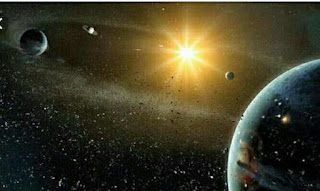Asteroid Belt - All things related to asteroid belt in our SolarSystem|Technospace
Asteroid Belt is a belt consisting of asteroids which is revolving around our Sun like other planets.
First of all, let's know what are asteroids ?
Asteroids are very small planets or planetoids that are found mainly in a belt between the orbit of Mars and Jupiter. Each asteroid present in the belt has its own orbit. The orbits of all the asteroids taken together forms the large band of asteroids. Astronomers have discovered more than 500 asteroids which are larger than 48 km in diameter.
The asteroid belt was first discovered in 1801.
The asteroid belt was first discovered by Giuseppe Piazzi. He first discovered when he first saw ceres. One another big asteroid is spotted after fifteen months and was named Pallas.
The whole asteroid belt is revolving around the Sun due to the gravitational pull but as the two planets Mars and Jupiter are there; so there gravitational push is keeping the belt in order.
Ceres is the biggest asteroid in the asteroid belt.
There are 1.9 million asteroids in the asteroid belt.
The asteroid belt is situated 2.2 to 3.2 Astronomical unit from the Sun.
How asteroid belt was formed ?
Early durimg the formation of solar system, the dust paricles which all around our solar system comes into a oval orbit order and forms the belts due to the gravitational force of Mars and Jupiter.
But, some people told that the parts of the two planets came together to form it.
What is the formation of the asteroid?
Most of the asteroids in the asteroid belt are made of rock and stone, but a small part of the asteroids contain iron and nickel metals. The remaining asteroids are made up of a mix of iron and nickel with carbon-rich materials. Some of the more distant asteroids can contain more icesas because they are far apart the sun. Though they are not large enough to balance and keep an atmosphere, but there is evidence that some asteroids contain water.
What are the types of asteroids?
- C-type asteroids consists of more than 75 percent of asteroids. The "C" stands for carbon, and the surfaces of these are super dark and are almost black like coal. Carbonaceous chondrite meteorites on Earth have a similar composition, and are thought to be pieces smashed off of the larger asteroids. The C-type asteroids are mainly present in the belt, according to the European Space Agency, they make up only about 40 percent of the asteroids which are closer to the sun. These include subgroups of B-type, F-type, and G-types.
- S-type asteroids are the second most common type, which makes up about 17 percent of asteroids. They are present in the inner asteroid belt. They are brighter and have metallic nickel and iron mixed with iron and magnesium-silicates. The silicaceous stands for the word 's'.
- M-type asteroids ("M" for metallic) are the last major type. These asteroids made up of pure nickel and iron and are also bright. They are found in the middle part of the asteroid belt.
- A type, D type, E type, P type, Q type and R type are the other types of asteroids present in the belt.


Comments
Post a Comment